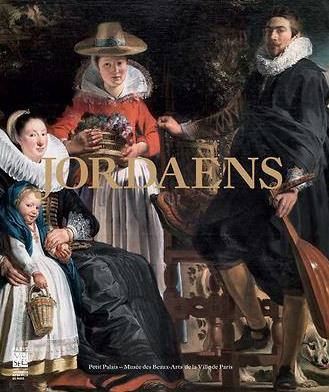Jordaens: the Pride of Antwerp
19 September 2013 – 19 January 2014
Petit Palais

Jacques Jordaens (1593-1678)
The Painter’s Family, 1621-1622
© Madrid, Museo Nacional del Prado
Backed up by superb scenography and numerous loans of remarkable works from leading French and International museums, this retrospective will restore Jacob Jordaens (1593-1678) to his rightful place as the pride of Antwerp. Still hard at work more than thirty years after Rubens’ death in 1640, Jordaens’ long career and the ability to turn out sizable, dazzling canvases with the assistance of a rigorously organised workshop, saw him provide a whole section of Europe with altar paintings and large, mythological compositions. At a time when Antwerp was in decline as the Continent’s economic capital, Jordaens kept its prestige alive with the sheer abundance and colourfulness of his artistic output.

Jacques Jordaens (1593-1678)
Sainte Famille, vers 1620
© Southampton City Art Gallery, Hampshire, UK/ The Bridgeman Art Library
On loan from collections not only in Belgium, but also in Russia, America, Sweden, Hungary, Jerusalem, Madrid and Vienna, the 120 works on show at the Petit Palais are an eloquent testimony to the extent and variety of his inspiration: from family portraits to large religious works, from the famous Flemish Proverbs series to banquet scenes, such as The King Drinks and tapestry cartoons. Here, we see a bourgeois man who hardly ever left his home city drawing on a host of sources ranging from Rubens to Caravaggio, the Venetian Renaissance masters and the heritage of antiquity, and combining them with the personal verve that won him international renown.

Jacques Jordaens (1593-1678)
Adoration des Bergers, 1616-1617
© Musée de Grenoble
The exhibition is punctuated by information points which provide visitors access to the stories behind the works and to the painter’s ‘trade secrets’.

It is also accompanied, by a detailed, splendidly illustrated catalogue.
From an excellent review: (image added)
The influence of Rubens is crucial to any interpretation of Jordaens, but to call him Rubens’ successor is too strong. An ink sketch for Rubens’ The Deposition of Christ, produced by Jordaens while working in the master’s studio, demonstrates the younger artist’s vigorous grasp of composition, characterised by the tightly packed curves and counter-curves of figures tumbling over each other to be noticed. The subject of the painting becomes little more than a device, a clockwork key for this carnival of forms and movement.
This can also be seen in Jordaens’ version of Rubens’ The Adoration of the Shepherds,(Adoration des Bergers,, above) where figures pile precariously above the virgin and child. Faces are contorted, arms flail – and the rigid head of a huge bovine protrudes into the centre of the painting. This bathetic addition is a particular idiosyncrasy of Jordaens’ and reaches its apex with the
Abduction of Europa,
in which the artist’s concentration on fleshy nudes is almost outdone by his ardent depiction of the attendant herd of cows.
The exhibition also presents Jordaens’ lavish tapestries, and his scene decoration, showing an artist who thrived under bourgeois requirements for ostentation. A painter who inspired Delacroix with his studies of heads, Cezanne with his nudes, and Van Gogh with his cows, Jordaens is a figure worthy of re-evaluation. This exhibition offers a sensitively tuned approach, its honesty of appraisal enlivened by a lightness of touch.
Excellent review in French with lots of images
Even more images!

Jacques Jordaens (1593-1678)
Le Sacrifice d’Isaac, vers 1625-1630
Huile sur toile
© Milan, Pinacothèque de Brera

Jacques Jordaens (1593-1678)
Servante avec une corbeille de fruits et un couple d’amoureux, vers 1628-1630
©CSG CIC Glasgow Museums Collection


Jacques Jordaens (1593-1678)
Le satyre et le paysan, vers 1645
© Musées royaux des Beaux-Arts de Belgique, Bruxelles/Photo J.Geleyns / www.roscan.be

Jacques Jordaens (1593-1678)
Les Filles de Cécrops découvrant l’enfant Erichthonios, 1617
Anvers, Koninklijk Museum voor Schone Kunsten
© Lukas-Art in Flanders vzw/photo Hugo Maerten

Jacques Jordaens (1593-1678)
Adam et Eve (La Chute de l’Homme), vers 1640
© Photography Incorporated, Toledo,
Etats-Unis

Jacques Jordaens (1593-1678)
Mercure et Argus, vers 1620
© Lyon MBA-Photo Alain Basset
Jacques Jordaens (1593-1678)
Le Roi boit, vers 1638-1640
© Musées royaux des Beaux-Arts de Bel-gique,
Bruxelles/Photo J. Geleyns / www.roscan.be

Jacques Jordaens (1593-1678)
Les Quatre évangélistes, 1625-1630
© RMN-Grand Palais (musée du Louvre)/René-Gabriel Ojéda

Jacob Jordaens,
‘Le Repos de Diane’, c. 1640 /
© Stéphane Piera / Petit Palais / Roger-Viollet

Jacques Jordaens (1593-1678),
Autoportrait de l’artiste avec sa femme Catharina van Noort, leur fille Elisabeth et une servante dans un jardin, 1621-1622,
